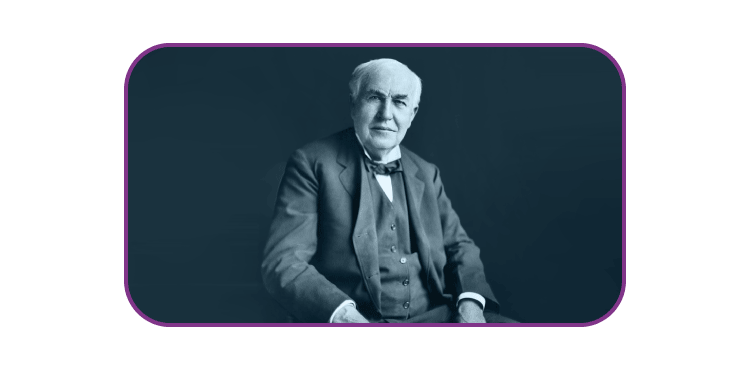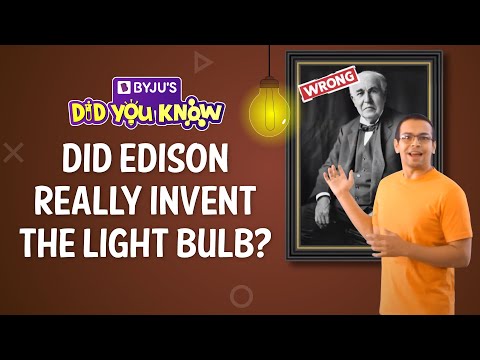Thomas Alva Edison, being one of the most creative inventors of all time, was considered a true gem in the world of inventions. He also spent a significant part of his life giving contributions to the world of designs that had an incredible influence on modern life. The creation of the incandescent light bulb, the phonograph, and the motion picture camera, as well as improving the workings of telegraph and the telephone, were some of his astonishing inventions. Thomas Alva Edison was also a successful businessman and innovator who managed to change the lifestyle of people through his essential innovations and improvements in a wide range of fields.
Table of Contents
- About Thomas Alva Edison
- Education, Career and Achievements
- The invention of the Light Bulb
- The Phonograph
- Edison’s Contribution in the Field of Electricity
About Thomas Alva Edison

Thomas Alva Edison was the phenomenal American inventor who holds the world-record of 1093 patents. Also, he created the world’s first industrial research laboratory. Edison was born on 11th February 1847, in Milan, Ohio – U.S.
Edison’s patents and numerous inventions contributed significantly to mass communications and telecommunications. Stock ticker, phonograph, the practical electric light bulb, motion picture camera, mechanical vote recorder and a battery for the electric car were some of his notable inventions.
He sold newspapers to passengers traveling along the Grand Trunk Railroad line during his early years. This led him to start his own newspaper named as the ‘Grand Trunk Herald’. The access to up-to-date information in this newspaper became quite a hit between the masses. Also, it was the first of the many more to come business ventures by Edison.
Education, Career and Achievements
- Education:
- Thomas Alva Edison always had a thrust of knowledge within him, and due to that, at an early age, he started reading a wide range of books and different subjects.
- Edison’s higher education did not include any university or attending college; instead, he was primarily self-taught.
- The absence of a well-defined curriculum led him to develop the skill of self-education and independent learning, which remained with him all his life.
- Career:
- He began his career as an inventor when he moved to New York.
- He devoted the decade of the 1870s to conducting experiments on the telephone, phonograph, electric railway, electric lighting, and other developing inventions.
- His first round of fame was brought by the design of the phonograph in 1877, which took his status to greater heights.
- He formed Edison Electric Light Company in 1878 in New York City.
- Achievement:
- He was felicitated with several awards and medals for his generous contribution to humankind.
- Some of them include the Distinguished Service Medal by the U.S. Navy and Congressional Gold Medal by the U.S. Also, he was decorated with the “Officer of the Legion of Honour” by France.
- He was welcomed into the New Jersey Hall of Fame and Entrepreneur Walk of Fame.
The invention of the Light Bulb
The greatest challenge faced by Thomas Alva Edison was to develop a practical luminous, electric light. He accomplished this using lower current electricity, an improved vacuum inside the globe and a small carbonized filament which is a stitched thread that burned for thirteen and a half hours. He was successful in producing a reliable, long-lasting source of light.
Did Edison really invent the light bulb?

The Phonograph
The tinfoil Phonograph was Thomas Edison’s first greatest invention in 1877. It was the first machine to record and play a person’s voice. Edison recited the rhyme “Mary Had a Little Lamb” on a tin cylinder that captured the recording.
He also recommended other uses for the phonograph, such as letter writing and dictation, record music boxes, etc. Edison’s device phonograph played using cylinders rather than discs. It consisted of two needles, one for recording and one for playback.
Edison’s contribution in the field of electricity
A system of conductors, meters, current switches, etc. was designed by Edison as he knew that his light bulb invention would be ineffective without a proper method to deliver electricity. Edison improved the designs of generators, which led him to invent more efficient power output generators than the existing ones at that time. Hence, this was marked as the beginning of the electric age.
For more such interesting articles, stay tuned to BYJU’S. Also, register to “BYJU’S – The Learning App” for loads of interactive, engaging Physics-related videos and an unlimited academic assist.
Frequently Asked Questions
Name some of the incredible inventions of Thomas Alva Edison.
Thomas Alva Edison is famous for his incredible inventions like the light bulb, phonograph and motion picture cameras.
How did Thomas Alva Edison invent the lightbulb?
Edison invented the light bulb by passing electricity through a thin platinum filament packed inside a glass vacuum bulb.
What is a filament?
A filament is a metallic thin wire or thread inside a bulb that lights up when electricity is passed through it.
What is a phonograph?
It is a form of gramophone using cylinders to record and reproduce sounds.
How many times did Thomas Alva Edison fail while inventing the light bulb?
Thomas Alva Edison made 1000 unsuccessful attempts before getting the final result.
Comments